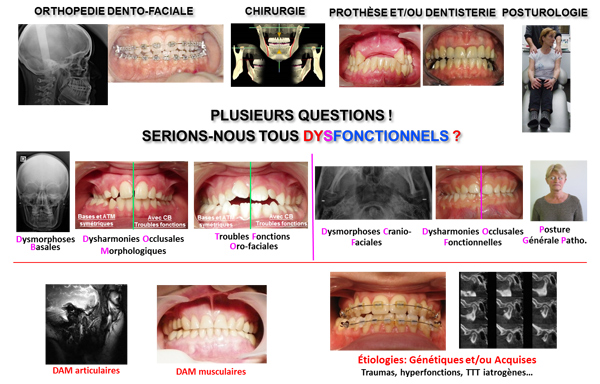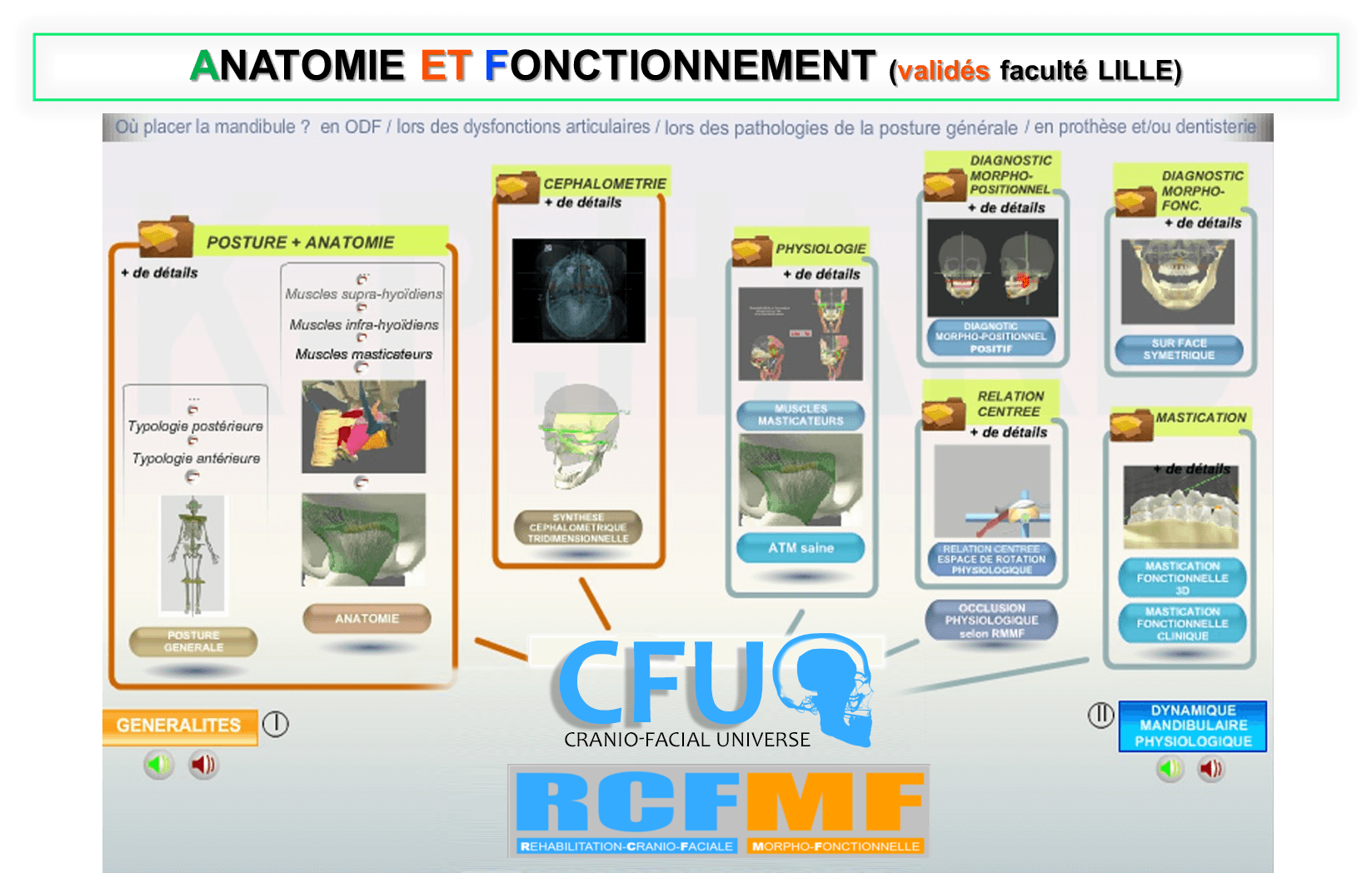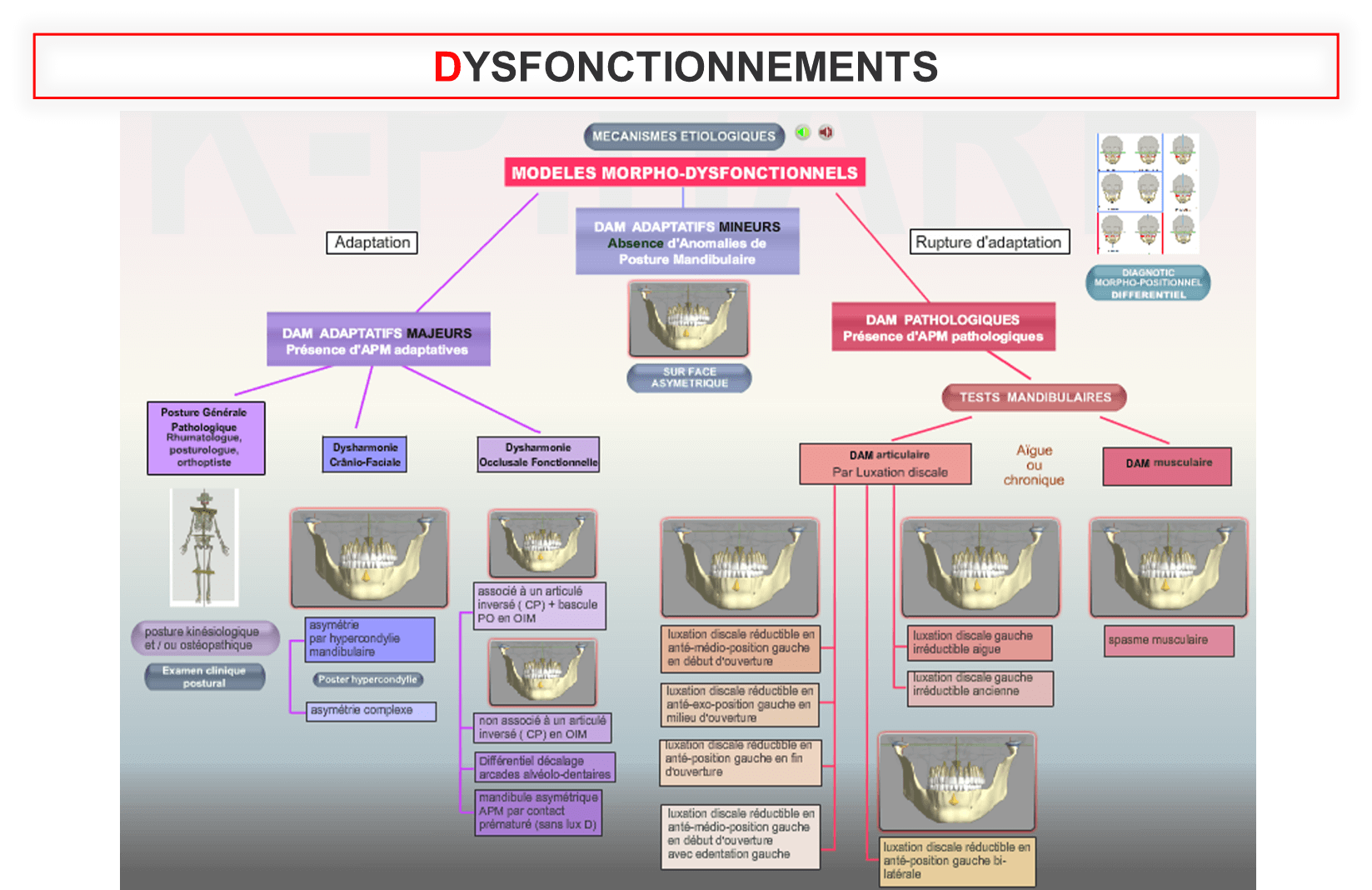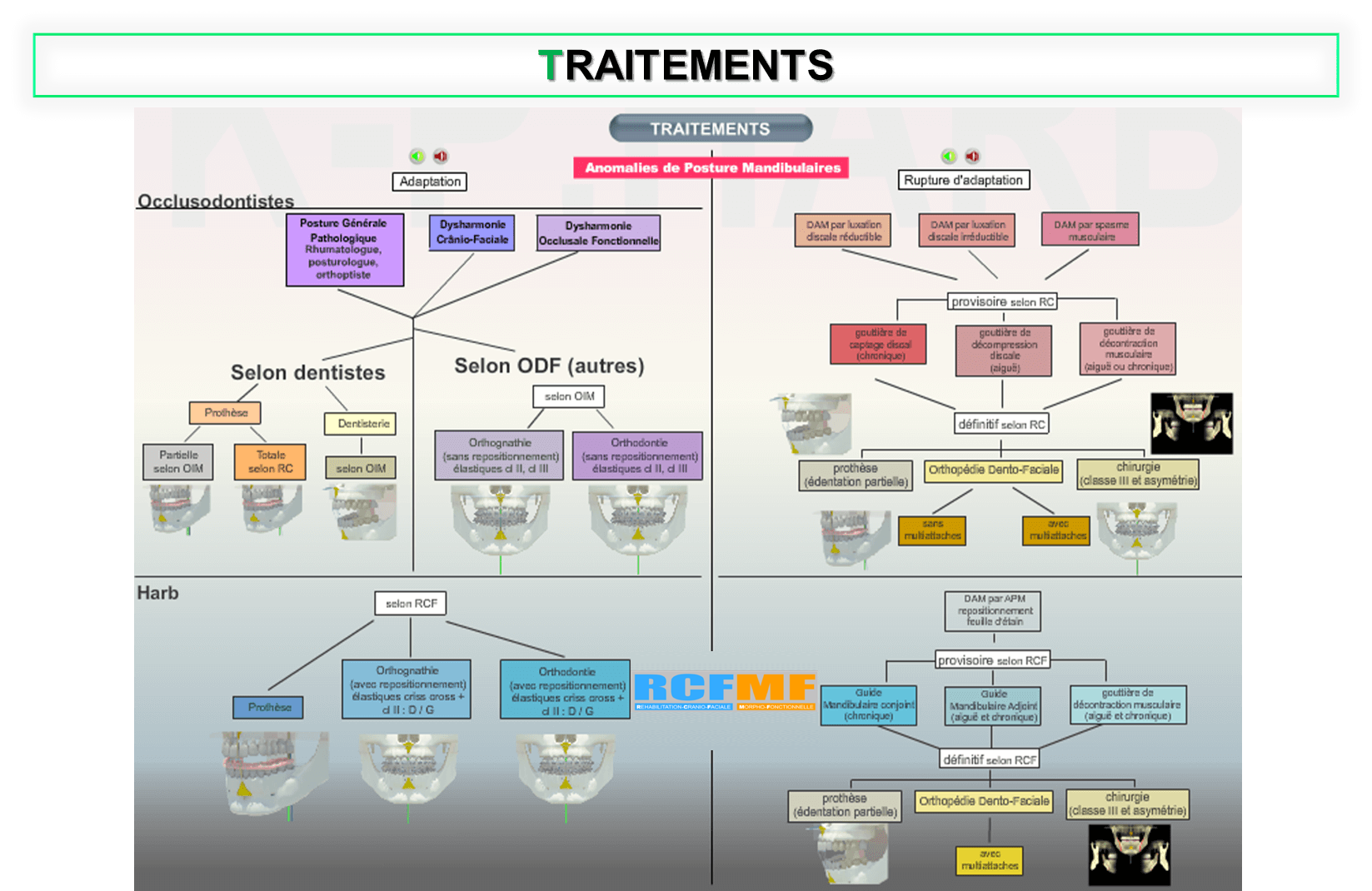FORMATION
INTRODUCTION
Inspired by everyday practice, according to Dr. Philippe Harb, whether it is regarding Orthontics, prosthesis and / or dentistry, or surgery or even in posturology, would we not all be dysfunctional?
Indeed, in our daily practice we only rarely, if ever, get perfectly harmonious patients, in class I, symmetrical without orofacial disorders without joint disorders and in perfect organic and psychological health.
We need a reference of "Normal", the morpho-functional model et une classification de l'"Anormal", the morpho-dysfunctional model and their diagnosis and treatments...
We are faced with rather different Dysfunctions of the Masticatory System: A general view taken from the DAM classification according to the MFCFR : minor Adaptive DAM , major Adaptive DAM, pathological DAM. The multifactorial, genetic and / or acquired etiologies; traumas, hyperfunctions, iatrogenic treatment ...
The balance or imbalance of the FIVE entities that make up the craniofacial assembly are at the origin of "normality" or Operation of the masticatory system (FAM) or "Abnormality" Malfunction of the Masticatory System (DMS).

In orthodontics as in prosthesis and maxillofacial surgery, could our interventions cause disorders in temporomandibular joints, tooth-articulation disorders, general posture disorders? ... The answer is unfortunately, yes! Why?

Our diagnostics are often incomplete and inaccurate, performed from the "side-view" and rarely in frontal view, much less in axial view, or the cranio-side is a volume; the deformities are three-dimensional and interfere with each other.
Also, our diagnosis are often imprecise, indeed our patients are examined in occlusion of Inter-cuspidation Maximum (IOM), the patient is asked to open close ..., and we class such occlusion and typology: Class I Class II ... or the IOM obscures the mandibular posture defects and there is false diagnosis and treatment.

Similarly, our treatments can be iatrogenic, unsuitable prosthesis, unwanted movements in orthodontics, second non banded molars... which can cause mandibular posture abnormalities.
Indeed the mandible is the only movable cranio-facial structure, its various positions complicate our diagnosis and treatment.

But where, when and how do we place the mandible; in dento-facial orthodontics, joint dysfunction, in diseases of the general posture, prosthesis and / or dentistry?
The MFCFR offers answers, supported by clinical cases and 3D animated films.
"Another way" to approach the patient as a whole. Dental diagnosis and treatment in 3D of the five entities and the identification of the common mistakes
"Another philosophy" biomechanical and functional. Posture and mandibular dynamics by new concepts of physiology, pathology, adaptation, based on fundamental and clinical data.
The ultimate goal: to preserve or reproduce balanced five entities for harmnious manducation; grip (opening-closing), incision, functional chewing and swallowing.
1- MORPHO-FUNCTIONAL MODEL: references of the "normal"
FAM: While it is true that "perfectly symmetrical cases" are rare, for didactic purposes, we define that a "normal" operation of the masticatory system (FAM) requires the status of the FIVE entities to be harmonious in the three directions of the space, and to be associated with orofacial functions and chewing with FOUR its conditions that are balanced.
The FIVE HARMONIOUS ENTITIES :
- Harmonious three-dimensional craniofacial morphology
- Dental Articulation
- Disco-ligamentary system of TMJ
- General and local muscular harmony
- General functional posture, physiological
The FOUR HARMONIOUS CONDITIONS :
- Relation "Centrée" Fonctionnelle dans l'Espace de Rotation Condylien Physiologique
- Ouverture-Fermeture rectiligne
- Occlusion Pysiologique proche de la denture naturelle
- Mastication Fonctionnelle suivie d'une déglutition physiologique
2- MORPHO-DYSFUNCTIONAL MODEL: references of the "abnormal"
DAM is a syndrome characterized by a "biodynamic" unbalanced manducatory pattern. Any disruption in the joints, occlusal, local or general muscle, causing deviated mouth opening and closing, limited, hampered chewing, painful and disturbed swallowing, constitutes according to etiologies, dysfunctional syndrome of the minor adaptive masticatory system or major adaptive or pathological.
The dysfunction is adaptive minor in Morphological Basal Disharmony, Morphological Occlusal Disharmony (DOM) and disorders of the orofacial functions not associated with Abnormalities of Mandibular Posture (APM). Without touching on the posterior determinant, excursions are dysfunctional by deformities and disorders of the orofacial functions, NO pain, joint noises, deflection, blocking limitation.
The dysfunction is adaptive major in the basal (TMJ) deformities; Functional Occlusal Disharmony (DOF) and disorders of the orofacial functions associated with abnormalities of adaptive Mandibular Posture, themselves due to a pathological general posture, to craniofacial deformities or Occlusal Functional disharmony. This dysfunction touches on the posterior determinant where mandibular excursions are dysfunctional, but by adaptation they remain WITHOUT pain, joint noises, deflection, blocking, limitation, but with deviation between the rest position and OIM.
Finally the dysfunction is pathological (inevitably major) in relation to posture pathological Mandibular Defects, themselves due to the rupture of adaptation (by incoordination condylo- articular disc and / or disorders of bone structures, or muscle by muscle spasm during stress and hyperfunctions), therefore mandibular excursions are dysfunctional WITH pain (in acute cases), joint noises, deflection, blocking, limitation. Note that the pathological dysfunction may exist in patients WITH OR WITHOUT basal and / or alveolodental deformities and / or disorders of the orofacial functions. Let us add that these syndromes can be added to and that the etiologies may be genetic and / or acquired.
The treatments
- Usual treatments of occlusodontists
PATHOLOGICAL CASES : reducible, irreducible disc-condyle incoordination, and muscle spasm. Provisional and definitive treatment either according to RC or not even with condylar references. Provisional treatments are carried out by occlusal splints:
- of disc recovery
- of decompression
- of relaxation
The final processing is done by the prosthesis and / or the ODF or maxillofacial surgery. The common element:
Placing a grinding groove in the splint and positioning the mandible according to this reference
- The treatments according to RCFMF
The TMD (temporo-mandibular disoders are characterized by the Mandibular Posture Abnormality (MPA). Hence the joint and muscle treatments involve trispatial mandibular repositioning, according to the RCF :
- Provisional treatments:
GMC (mandibular joint guide) or glued repositioning wedges: chronic cases
GMA (auxiliary mandibular guide) or repositioning splint: acute and chronic cases
Smooth repositioning splint: acute and chronic muscular cases
- The definitive treatments
After repositioning according to the RCF (real decompression):
Auxiliary and / or joint prostheses
ODF
Maxillofacial surgery
Adaptive cases:
The usual treatments according to dentists
Partial prosthesis performed in OIM
Total prosthesis according to the RC
The usual treatments according to orthodontists
In orthognathy as in orthodontics, they are performed in OIM
The treatments I offer:
Our treatments are carried out according to the RCF
- General pathological posture The patient is addressed in rheumatology, posturology
- in prosthesis as in orthognathy, orthodontics and surgery
STORY ICI (EN)
FORMATION CAS CLINIQUES VIDEO (EN)
QUESTION/REPONSE (EN)
INTERVENTIONS ET CONFERENCES PASSEES ET FUTURES (EN)
When browsing our site, you may find these abbreviations. Here is their meaning:
|
RCF: "Centered" Functional Relation RDD: "Off Center" Dysfunctional Relation IOM: Occlusion of Inter-cuspidation Maximum. POM: Maximum Opening Position LD: Right Laterality. LG: Left Laterality. PM: Maximum Propulsion. OF: Open-Close. OP: Physiological Occlusion. MF: Functional Chewing. |
SS: Sagittal direction. SV: Vertical Direction. ST: Transversal Direction. FLS: Superior Labial Frenum represented by V. FLI: Inferior Labial Frenum represented by ˄. CII: inter-maxillary Incisive Center. Cii: Inter-incisive mandibular center. CB: Cross Bite. FAM: Operation of the masticatory system. DAM: Malfunction of the masticatory system. DCF: Cranio-facial dysmorphia. DOM: Morphological Occlusal Disharmony. DOF: Functional Occlusal Disharmony.
|
(à traduire)
Le cabinet d’orthodontie du docteur Philippe Harb est situé à Saint-André Lez Lille. Le docteur vous accueillera dans un lieu chaleureux et équipé des derniers équipements technologiques afin de garantir des traitements d’orthodontie du plus haut niveau. L’orthodontiste Lille est assisté par deux assistantes pour apporter un confort maximal à ses patients.
- Nous pratiquons des traitements esthétiques céramique et non du transparent plastique. Pour les appareils métalliques nous proposons des ligatures de couleurs (rouge, fushia, mauve, bleu…)
- Le cabinet dispose d’une radiographie numérique : un minimum d’irradiation pour le patient, plus écologique, plus rapide, meilleur qualité de diagnostic et donc des soins.
- Concernant la stérilisation, nous disposons de la chaîne réglementaire ; à froid, par ultra sons, puis par stérilisateur à chaleur humide...
Le concept de ce cabinet d’orthodontie est de pouvoir prodiguer les soins et les traitements les plus performants tout en conservant la proximité et la chaleur d’un accompagnement personnalisé et unique par le docteur Philippe Harb.
DOCTEUR PHILIPPE HARB
Dr. Philippe Harb is an Orthodontist in the Lille area, Spécialist Qualified in Orthopaedics Orthodontic DentoFacial, but also in the correction of the dysfunctions of the Manducator Device; "pain of the jaws, headaches ...".
Dr. Philippe Harb has initiated a vast project since 1988: The Three-dimensional Mandibular Concept, which has evolved towards Morpho-Functional Mandibular Rehabilitation and then definitively towards "Morpho-Functional CranioFacial Rehabilitation".
Using the 3D animation and the skills acquired during his studies, combined with his experience in the field of orthodontics, Philippe Harb has developed new techniques for the diagnosis, care and treatment of DAM : The Morpho-Functional CranioFacial Rehabilitation..
Beyond the didactic aspect, Philippe Harb wanted to make his knowledge accessible to all. Its aim is to put its skills and experience at your service so that you, orthodontist, dentist, can appreciate its innovative methods and apply them in your professional field.
Doctor Philippe Harb is appreciated for his extreme availability and his taste for well-done work. He enjoys sharing his knowledge and discoveries to make maxillofacial surgery and orthodontics more modern, focused on new technologies and quality.
Doctor Philippe Harb proposes to you to explore his work and to appreciate its numerous discoveries through a collection of didactic videos in self-service, in renting or with the purchase.